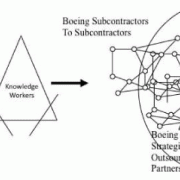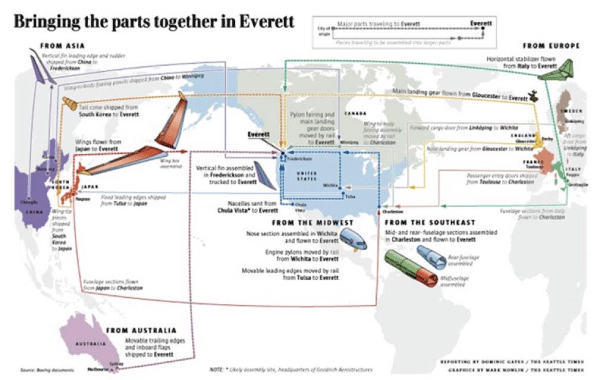Although some may argue that IT's capacity to contribute to business competitiveness has faded, we suggest instead that it has evolved and expanded, maturing and changing within a subset of companies that have effectively managed to use IT in various ways. In this two-part Executive Report series, we examine the status of the use of IT to improve organizational capabilities and promote business value, identifying varieties of use and directional trends as well as managerial challenges and critical success factors through five case studies. Here in Part I, we explore the first two: the Boeing 787 and JPMorgan Chase.
Long ago, IT established itself as a source of organizational capabilities and business value. From the earliest days of computing using devices conceived as very fast calculating machines to automate repetitive, mundane tasks to generate efficiencies to today's multiple personal devices of digitized products and services that accelerate innovation, we have witnessed far-ranging ways in which information technology has create business value. Although some may argue that IT's capacity to contribute to business competitiveness has faded, we suggest instead that it has evolved and expanded, maturing and changing within a subset of companies that have effectively managed to use IT in various ways.
However, not all companies achieve equal success with their mature approaches to IT-based capability and value creation. Thus, in this two-part Executive Report series, we examine the current status of the use of IT to improve organizational capabilities and promote business value, identifying varieties of use and directional trends as well as managerial challenges and critical success factors. We carry out this examination through five cases of real organizations striving to use IT to develop capabilities and business value. In conducting these studies, we surveyed relevant literature and investigated the subject firms in detail. We made use of our personal IT industry networks and sources ranging from media to direct interviews of experts, analysts, and staff members within the firms themselves. Finally, we chose subject firms across a large span in order to capture as much variety as possible regarding the use of IT to create business value.
IT Value Creation
A remarkably prescient group of early technology pioneers first conceived the vision underlying modern, Internet-based IT value creation. In a 1945 Atlantic Magazine article, "As We May Think," Vannevar Bush anticipated the interconnectedness and indexing structures of the Web. 1 Later, in 1968, J.C.R. Licklider and Robert Taylor visualized a world in which IT would enable creative collaboration in their paper "The Computer as a Communication Device." 2 An inspired group of innovators emanating from a core at MIT and a few other academic institutions worked over a period of almost 40 years with what, in retrospect, looks like a singular purpose. Eventually, their work led to the 1995 Netscape IPO, that moment in history when the business world woke up, on a massive scale, to the idea that IT would be a major source of business value. It is ironic, then, that a mere eight years later, in 2003, Nicholas Carr would announce that IT had run its course, and that, from a competitive perspective, it "no longer mattered" 3 -- commentary by Carr that we all know continues to bring about further debates today.
As we will show in this Executive Report series, we believe Mr. Carr was mistaken. IT has, if anything, become a source for more varied and important new capabilities and new business value, including competitive differentiation. Certainly, some kinds of IT value creation have indeed commoditized, ceasing to be a factor in the business competitiveness equation. In fact, many former categories of value creation, especially those related to automation of mundane tasks or aimed purely at efficiency gains, have become degraded in competitive terms. For instance, few companies outperform their rivals because of their accounting or email systems. But the visions of Bush and others did not rest on the conception of computers as merely faster calculators. Indeed, many of the more advanced forms of IT-based value creation -- especially those that fuel innovation and create emergent value -- are only now becoming appreciated by businesses, and few companies have fully achieved the potential value available from the more mature conceptions of IT as a source of capability and value.
The process of identifying actual contributions of IT investment to the creation of new capabilities and new business value has always been somewhat complicated by the efforts of those who obtain business value and then disguise IT's contribution, striving to protect the value from being accessed by others. The urge to safeguard proprietary sources of differentiation from competitors is quite natural, though, we suspect, less effective than many imagine. Simply seeing what another company is doing to create business value has never been the same thing as being able to do the value creation in your own organization. Generations of auto executives learned this lesson the hard way, as they toured Toyota factories and then returned to spend vast sums on copying the Toyota Production System (TPS), only to discover that value from their efforts usually eluded them.
Thus, the task of identifying and understanding IT benefits (or any business benefit, for that matter) amounts to subtle "detective work," sorting out fact from fiction. In this report series, we approach this task by examining "visions" of IT benefits -- ways that companies have attempted or continue to attempt to create new capabilities and new business value from IT -- and comparing those with a rigorous examination of the resulting realities: investigating whether the benefits have materialized or whether they seem to be on their way to materializing.
A further complicating factor in understanding the potential business value of IT is the management difficulty involved in achieving IT benefits. Apart from the quality of a plan or strategy for obtaining new capability and value from an IT investment is a matter often referred to as "execution." In order to implement new technology, the technology itself must be mastered, and associated nontechnology changes should be made, including structural adjustments to the organization, acquisition of new skills and elimination of skills (or people) no longer necessary, and integrating the technology into the company's culture. Essentially, it's about changing the way that "work gets done."
The management difficulties confronted in execution often accumulate until they reach a level in which the value realized is substantially reduced, or, in some cases, in which the difficulties become so overwhelming, the projects are terminated (or worse). Consequently, our research methodology in this report series strives to separate analysis of the potential IT-based capabilities and value (i.e., whether the capability and value-creation idea is conceptually sound) from issues of management difficulty on the way to potential benefits (i.e., execution issues). Sometimes a value creation is flawed; other times, the plan is fine but the execution is problematic. In some rare but happy instances, both the plan and the execution are good -- and of tremendous value, including in competitive differentiation.
The Foundations of Visions of IT Benefits
Regardless of kind, all IT benefits arise, in one way or another, from the workings of Moore's Law, which says that the power of computers available at a given cost doubles roughly every 18 months; or alternatively, that the cost of a given amount of computing power is reduced by half every 18 months. The practical effects of Moore's Law on the cost of transactions, over a period of years, are dizzying. Recall how the early vision of a "mainframe on everyone's desk" came into being with the personal computer. The computing power of a mainframe computer that cost millions in the 1960s could be acquired from a PC for pennies in the 2000s. In fact, the approximate cost of the power of a 1960s mainframe computer reached about US $3,000 in 1980, which was about the time of advent of the IBM PC.
We can glean another vision from history, one that originated from AT&T in the 1950s. AT&T concluded that to accommodate the growth in the use of telephones, by 1960 everyone in the US would have to become his or her own telephone operator. This is exactly what happened. By the early 1960s, traditional AT&T telephone operators had been disintermediated by individual telephone users who "switched" their own calls using automated switching machines activated by personal telephone handsets. The reduction in the costs of that technology, and the commensurate growth of use, led to a decentralization of control of the technology. As control of technology spreads, people imagine new ways to use it -- functions that create value, some of it unique to their own situations. These functions generally extend well beyond what the developers of the technology had imagined.
Consider the path of the PC. Bill Gates reasoned analogously in recognizing that at $3,000 the cost of a PC reached a tipping point, leading to just about everyone owning a computer. Like the telephone, he anticipated that control of this technology would also decentralize and that the opportunities for value creation would expand as the computing power available at that price improved. By the 2000s, $3,000 would buy a computer almost 200,000 times more powerful than the original IBM PC. Microsoft, Apple, and many others applied this extra power to the disintermediation of programmers. As such, "everyone became a programmer" through the development of user-oriented applications, such as word processing and spreadsheets.
Such radical decentralization led to other important visions with potential IT benefits. If something could be "digitized," it could benefit from being "computerized," realizing the declining costs of computers (Moore's Law) in ways that surprised many who had adopted computers primarily because they offered to lower the cost of doing the same-old transactions, but which would not have surprised Bush, Licklider, or Taylor. The application of computing power transitioned from a straightforward increase of speed of value-creating transactions to the facilitation of communication and creative collaboration. Today's mobile platforms and the collaboration tools of the Internet are prime examples.
Over the years, we have seen computerized applications become more "interactive." Users can try something, look at the result, and then try something else, very rapidly, and often collaboratively. At some point, the conception of the computer transitioned from being a "machine to automate" to a "machine to collaborate." The emergence of widely used graphical interfaces and digitized, hence extremely changeable/pliable, artifacts opened up a wide variety of applications for IT, including simulation, rapid prototyping, crowdsourcing, and coordination of virtual organizational structures. User-oriented applications advanced along a path from computerizing mundane operations to advanced communication vehicles via text, voice, photos, videos, 3D models and, eventually, to just about everything being digitized. It is many of these advanced-capability and value-creation possibilities that we had to work hardest to discern in our case studies.
Adages of 21st-Century Capability: Evolving Propositions for IT Value Creation
Over the years, several adages that relate to potential IT value, or visions of IT value, in the age of total digitization have emerged. These include:
- "Time is money." IT enables real-time, globe-spanning communications. One dramatic example of this potential value from IT is through the elimination of static inventory due to just-in-time delivery from suppliers. Today, parts are delivered to the point in time and space when they are precisely needed for assembly. The 20th-century alternative was to inventory parts and buffer stock -- "just-in-case" inventory -- so that the assembly line never shut down for lack of access to parts.
- "The information about the money is more valuable than the money." We attribute this adage to Walter Wriston when he was CEO of Citibank -- at the dawn of IT penetrating business. In this case, IT's potential value is in enabling real-time search and communications of information to global entrepreneurs about the funds available to finance ideas and innovations, connecting those who have money and want higher returns with those who have value-creating ideas. Wriston concluded that it was more profitable for Citibank to concentrate on IT-enabled investment banking, which did not require a business unit to attract money into deposit accounts, then sell the money through loaning it out, garnering profits from the "spread."
- "Investments in IT-enabled information resources is better than investing in physical brick-and-mortar resources." The classic example of this adage is in the alternative of building a brick-and-mortar resource, such as a warehouse, geographically close to its retail stores to increase customer service versus investing in a dynamic IT customer demand system by geographical location in order to track demand simultaneously with tracking railroad car movement from manufacturer to distribution center. The latter involves reconciling the current location of demand with the current location of in-route railroad boxcars and then rerouting inventory to match the delivery of goods to the location of demand.
- "Digitization of 'stuff,' enabling precise measurements of the stuff and delivery across geographical space." A straightforward example of the IT-enablement of this adage is Amazon's Kindle. This digitization innovation led to communicating with readers in real time, alerting them of books that they might be interested in and then allowing them to conveniently download those books and begin reading them instantly on their Kindles.
- "If a picture is worth a 1,000 words, a digital prototype is worth a 1,000 pictures." Technologies that allow digitized artifacts to be quickly and easily manipulated and communicated can lay the groundwork for the consistent emergence of unanticipated value. Consider this example: one researcher we know, having trouble getting a rental car into reverse, used Twitter to send out word of his difficulty. Within minutes, he received advice that allowed him to solve his unanticipated, very idiosyncratic problem. Rapid prototyping technologies similarly allow us to rapidly experiment with an artifact, sometimes realizing value in ways different from what we expected.
These adages express different forms of IT-based value creation, a variety that we saw demonstrated repeatedly throughout our study.
The Case Studies
We selected cases to span a range of industries as well as a range of uses of IT to create new capabilities and new business value. We also chose cases that we expected, based on past or insider information, to contain interesting IT value stories. Below is a brief summary of the five cases, along with reasons for selection:
- The Boeing 787 product-driven innovation project. IT underpinned the Boeing 787 project at every turn. IT was the means of coordination for dramatic new reliance on organizational disintegration from a traditional highly vertically integrated business. In this case, IT was the basis of conceptions of value creation in both old and new categories. Such an ambitious project would surely give us insight into execution issues as well.
- JPMorgan Chase enhancement of capabilities. JPMorgan Chase resulted from mergers and posed formidable integration tasks for the company. Whereas many companies struggle to survive a scenario, JPMorgan Chase managed to increase the value it derived from IT while conducting the integration. The case also provides contrasts with Boeing in the ability to retain skilled personnel during a merger and further contrasts with Delta XYZ (below) in managing the "blocking" leaders who oppose transition.
- Delta XYZ's troubled social media implementation. Delta XYZ (a fictitious name) had a grand plan to increase its rate of innovation by deploying social media technology throughout the company. Delta XYZ executed the deployment but achieved much less value than it had hoped. This case shows how organizational norms and culture interact and how they can curtail the possibilities for realizing IT capabilities and value creation.
- Crowdsourcing as a new initiative. This case explores an examination of several companies, all of whom have built business models around the emerging value-creation paradigm of crowdsourcing. We have included this collection of mini-cases because we wanted to examine IT value creation in leading-edge areas. This part of our study demonstrates that even within a seemingly narrow category of value creation, there is much variety in how value creation happens.
- Ascent Media's transition to digital services. The Ascent Media Group traditionally warehoused physical media (film, videotape, etc.) for its movie and TV studio clients, conducting business in ways that deployed IT to realize physical efficiencies. Under the threat of increasing media digitization, the company opted to move toward a vision that would create advantages in a more digital future. This meant a serious break from the past, using IT in new ways to realize new categories of value. The case demonstrates a wide variety of execution difficulties. In many ways, the Ascent case illustrates, better than any of our other cases (with the possible exception of Boeing), the full cycle of how IT can create new capabilities and value through a total transformation of a firm's business model.
After a period of extensive data gathering, we summarized our data into "case treatment" documents, then conducted within-case and cross-case analyses to detect major trends, helping us arrive at general conclusions. In this two-part Executive Report series, we provide summaries of the cases, identifying major observations in each, including management difficulties and general findings. Part I explores the first two cases (Boeing 787 and JPMorgan Chase), and Part II will examine the last three. Finally, in Part II, we will reveal a set of 12 overall findings that constitute the bulk of our results.
Case 1: The Boeing 787
On 15 December 2009 at 10:27 am PDT, the most technologically advanced commercial airliner in the world, the Boeing 787, began its maiden flight from Paine Field in Everett, Washington, USA. It landed several hours later at Boeing Field in Seattle, Washington, USA, having successfully validated a bold, project-driven transformation that featured IT new capabilities and IT value creation at almost every turn. 4
The vision for the Boeing's transformation originated in 1996 when then-CEO Philip Condit and his senior management team composed Boeing's 2016 strategy, which set the company on its road to bold decisions that included major acquisitions, business unit divestures, and unprecedented levels of outsourcing to global strategic partners. This vision required aggressive use of IT to design and manufacture the airplane, and, in particular, to create and coordinate a global supply chain to access business value in new ways. Yet, the 787 could not have been conceived at the outset of the 2016 strategy. The technologies needed, IT and others, were not available in 1996. Back then, the Web was just taking off, the Internet just beginning to commercialize.
Thus, the story of the 787 and its IT-enabled value creation is truly a story about evolution of technologies and emergent value. Evolving IT technologies and Boeing's increasing IT capabilities allowed the plane itself to become much more than just the company's newest product. Indeed, the Boeing 787 became the basis of a "project-driven" transformation of the company.
This fact leads us to our first major observation: the Boeing 787 project changed the structure of the company from a 20th-century functional hierarchy to a 21st-century IT-enabled global network. Figure 1 depicts the company's evolution from a vertically integrated, functional hierarchy to an extended global, virtually integrated network structure.
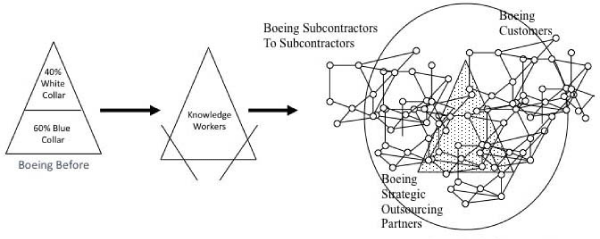
Figure 1 -- Boeing's virtual global network organizational structure.
Transforming a company from a 20th-century functional hierarchy to a virtual global network is a process that involves the creative destruction of the old organization, leading to the construction of a new organization. Here, IT applications that perform operational functions realize efficiencies and change information flows in ways that enable "downsizing" of the functional hierarchy. With further IT applications and their integration, a network structure begins to appear, alongside the functional hierarchy, eventually replacing it.
As part of this evolution from functional hierarchy to a virtual network structure, formerly internal activities migrate across the boundary of the firm to external suppliers. The superior coordinative capabilities made possible by maturing IT systems create the possibility for such outsourcing. Figure 2 shows the global movement of major airplane components among Boeing's 787 global outsourcers. These global movements are carried out by myriad types of transportation, eventually leading up to the use of the Boeing Dreamlifter (a specially modified 747) to transport major Tier 1 parts to Boeing's final assembly plant in Everett, allowing the company to "snap" together a completed 787 airplane.
Getting this to happen requires a set of precise drawings to specify each of the millions of parts that make up the airplane. Digitized versions of the drawing enable manufacturing of parts, assembly of parts into major components, movement of major components to final assembly site, putting the airplane together, and, finally, certifying the airplane for delivery to airline customers. This IT capability allowed the needed interface with the Boeing strategic partners. Access to these partners enabled Boeing to make aggressive product choices, deciding, for example, to use advanced materials that had not been previously used to the same extent in the commercial airline industry.
Such aggressive product choices generated competitive advantages for Boeing. In the case of the advanced materials, they had properties (low weight relative to strength) that would translate into favorable performance characteristics (longer range, better fuel efficiency). This leads us to another major observation: digitization of the physical artifacts that compose the 787, and the overall plane itself, enabled a degree of outsourcing that allowed the company to access unique capabilities wherever they resided in the world. These unique capabilities enabled aggressive product design choices and would generate competitive advantage.
Creating these new capabilities and value-creation possibilities required Boeing to modernize its almost 60-year-old IT infrastructure. Some of this work, consisting of standardization, database integration, and real-time infrastructure development, had been done in the 1980s. Figure 3 shows the actions Boeing took to modernize its legacy systems portfolio and create separate IT portfolios for a virtually integrated global supply chain to be used for its 787 airplane product and associated systems.
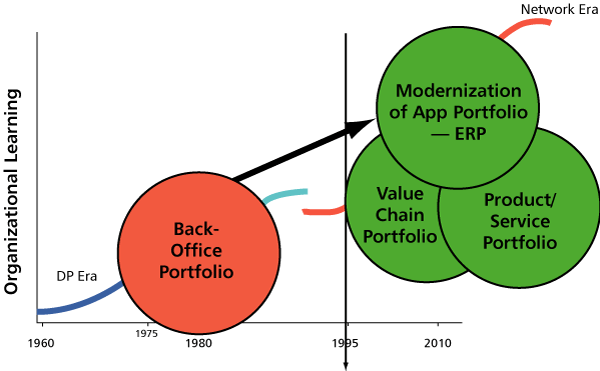
Figure 3 -- Boeing's product-driven portfolio business transformation.
Before reaching the network era shown in Figure 3, the company had to evolve past some organizational learning curves over the decades, including the mainframe era and the microcomputer era. 5 It was not until the network era in which companies could build the IT architectures that would enable real-time integration of global supply chains and real-time collaboration among global strategic partners in designing and manufacturing such complex product as the Boeing 787. While applications like CAD/CAM were developed during the first two IT eras, their overall management was not rationalized until they were pulled out of the legacy applications portfolio and then managed as separate portfolios in the network era. It was this type of evolution that occurred during the 787 product-driven transformation at Boeing. The project made clear that the design and operations of such a complex IT-enabled virtual organization would involve significant organizational change and learning. Boeing could not simply rely on its Tier 1 partners to completely ship components for the 787 as ready to be "clicked" together in three days time at final assembly. Rather, Boeing needed to extend its IT capabilities with Tier 1 partners down through Tier 2, 3, and 4 suppliers in order to effectively manage the virtual global supply chain for the 787.
Boeing's 2016 strategy of being a "large-scale system integrator" changed the focus from an airplane product to a product viewed as a set of "systems," providing value to the customer and revenue to Boeing. Enabled by IT integration, the view of the physical product itself (the airplane) shifts. This represents perhaps the most mature of IT value-creation capabilities, based on the generation of complementary revenues not necessarily related to the sale of a physical product. The case leads us to another observation as well: when IT integration can be fully unfolded, it results increasingly in new revenue sources in addition to, and in contrast with, cost-saving value creation realized on the way to a more revenue-orientated perspective.
Management Difficulties in Realizing Potential IT-Enabled Value
Boeing had experienced significant execution difficulties in pursuing its systems integration strategy, especially in making its virtual global supply chain work. Continued culture problems stemming from the merger with McDonnell Douglas exacerbated this difficulty. The strain of mixing two different cultures would drag on the company's ability to execute on its new systems integration strategy. Historically, meritocracy has characterized Boeing's company culture -- tasks and rewards are given to those of demonstrable ability -- especially in the area of aeronautical design and engineering. On the contrary, McDonnell Douglas has been characterized by a financial results culture. Postmerger, distrust among those from the two companies led to breakdowns and inefficiencies. Since the two companies were both large, Boeing at about $35 billion in revenue and McDonnell Douglas at $17 billion at the time of the merger, the postmerger environment was characterized by frequent clashes of company cultures, causing conflict in cooperative work between the two companies.
Often, systems or processes for accomplishing business tasks tie cultures. Processes and routines are often hardened into "the way things are done around here" mantra and are difficult to change. At the time of the company's new realignment toward systems integration, the two cultures were still entrenched. Additionally, the strategy of becoming a systems integrator led to the outsourcing of key elements of the aircraft rather than building it within (i.e., vertical integration), which was the norm at McDonnell Douglas and its military business.
Additionally, the systems integration strategy made it necessary for experienced employees to be moved to supplier locations to provide needed technical support and guidance. However, strained labor relations tempered the enthusiasm for senior employees to help suppliers. Earlier, Boeing retired large numbers of its most senior workers, leaving little slack to deploy assistance to suppliers.
With increased delays in the delivery of the 787, a stressed senior management team had little tolerance for further "bad news" -- that their Tier 1 suppliers and strategic partners were having problems -- that would be passed onto shareholders and stock analysts. Consequently, serious manufacturing and supplier performance problems were repressed or ignored, only to be discovered later upon assembly of the airplane. For instance, Tier 1 parts disgorged from the Dreamlifter were found to be unfinished and could not be snapped together to create a finished 787 airplane. As such, the Boeing team was forced to go back and readdress its supply chain problems and its Tier 1 supplier capabilities problems. Importantly, it was vital to resolve these problems, not in a dictatorial manner, but in a collaborative way. At this point, Boeing could not simply fire its suppliers and hire new ones.
This story leads to an additional observation: the integration skills possessed by senior employees were lost when those senior employees departed. These skills were acutely missed in the extended supply chain and appeared to be a complementary requirement, necessary to achieve the value created by extended IT-enabled networks.
Another important problem was communication across the various corporate entities of the virtual global organizational structure. At the time, Boeing was developing experience and expertise in composites, alongside its systems integration efforts, creating a longer first-mover advantage over Airbus and other competitors. The ability to "sense and respond" in real time, to understand and resolve problems with new materials, and to operate in a virtual global supplier network is crucial to 21st-century executive leadership and high-performance companies.
Summary and Findings
The Boeing 787 project demonstrates considerable management challenges and organizational learning costs associated with realizing the potential strategic value of IT. At the time of this study, Boeing had already incurred more than $10 billion of late-delivery penalty costs as it executed its strategy. However, it's also clear that Boeing had obtained a first-mover advantage with its bold strategy and new airplane. So while Boeing has led the way in pursuing a 21st-century potential IT value vision, what value Boeing will actually realize remains to be seen as the project currently suffers from design and manufacturing problems. Although Boeing has made some substantial sales of its 787 Dreamliner, the company recently hired a new manager to improve performance. 6
Four key findings about potential IT benefits and their capture arise from the Boeing 787 case:
- IT plus "digitization" enables new and unique ways to obtain competitive advantages through: (1) establishing virtual organizational integration enabling management to achieve razor focus on core capabilities; and (2) accessing a diverse and uniquely talented global workforce.
- The effective management and coordination of a global virtually integrated organization is an emerging challenge fraught with risks.
- IT plus "digitization" will likely continue to have a major impact on the changing nature of work, including where and how it's done.
- Culture clashes and other organizational effects that result in loss of, or failure to bring to bear, integration skills can generate very substantial difficulties in any effort to use IT to create new capabilities and value.
Case 2: JPMorgan Chase
The financial services industry offers some of the purest opportunities to achieve IT benefits. The "product," an intangible service, can theoretically be fully provided through IT networks -- no physical product or artifact need be involved. Bits and bytes alone can keep track of who owns money and money instruments. Further, services can be provided wherever there is access to a computer network.
The workings of Moore's Law are especially evident in the economics of financial services. According to some studies, the cost of executing a bank transaction amounts to $1.50 in a branch with a human teller, $0.50 via an automatic teller machine, or about $0.01 online on a PC. Such IT-enabled economics have resulted in dramatic transformation and consolidation in the financial services industry.
Indeed, IT has caused a sleepy industry based on face-to-face interactions and bread-and-butter practices for deposits and loans to evolve into a complex, abstract, global business that involves credit scoring and, sometimes, ultracomplex software for mathematical risk assessment of nonpayment of loans. Recall the adage mentioned earlier by Citibank's former CEO: "the information about the money is more valuable than the money." This conclusion led Citibank to engage in an aggressive strategy based on expansion of global investment banking activities.
In addition, repeal of the Glass-Steagall Act of 1933 in addition to the 1999 Financial Modernization Act removed the organizational separation that previously existed between Wall Street investment banks and depository banks, thus enabling vertical integration of various financial institutions such as JPMorgan Chase. The removal of such organizational barriers has a substantial side effect, however, which has been blamed by some for exacerbating the damage caused by the collapse of the subprime mortgage market that led to the recent financial crisis. The potential to make enormous profits, trading mortgage-backed securities with artificially high ratings, encouraged banks to take on otherwise intolerable risk in the form of bad loans. The ease with which people were obtaining home loans contributed to an artificial housing boom and exacerbated the inevitable decline.
IT-enabled transformation of the financial industry accelerated with Mike Milken's discovery, in his thesis work at Wharton, that relatively high-risk bonds of smaller companies were less risky in terms of default than the interest charged to the companies for the bonds would suggest. Milken took this finding to an investment firm, Drexel Burnham, which resulted in a windfall profitable business for that firm in selling what became known as "junk bonds." This general idea of using computer models continued to expand into businesses based on new financial instruments such as "packaged mortgage-backed securities," another source of windfall profits for financial services firms. People assumed that the computer models effectively provided information on the risks of these instruments... which was not the case.
The restructuring of the financial services industry disintermediated many players, including banks, insurance companies, and brokerage companies, and yielded integrated, full-service financial conglomerates that could directly provide one-stop financial services to customers. For example, online interfaces ultimately transferred .service labor to the customer. Figure 4 illustrates the evolution of the financial services industry. The term "cloud entity" metaphorically captures the organizational/technological concept of a virtual global financial services organization that employs a technology that allows access to IT databases that can exist anywhere on the global Internet.
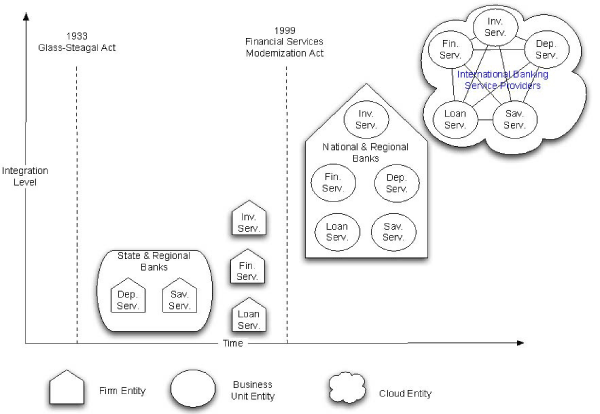
Figure 4 -- Changes in financial services industry on global scale.
Due to these industry changes, incumbent financial services firms had to make changes to their own IT applications and infrastructure portfolios if they wanted to survive. The resulting modernization required intense organizational learning. Revisiting Figure 3, Figure 5 shows some of the changes required for firms to compete in this new era. Although this is a generic illustration of how a financial institution might migrate its legacy applications portfolio into a transformed 21st-century financial conglomerate set of application portfolios, it roughly describes the transformation that Jamie Dimon, CEO of JPMorgan Chase, executed.
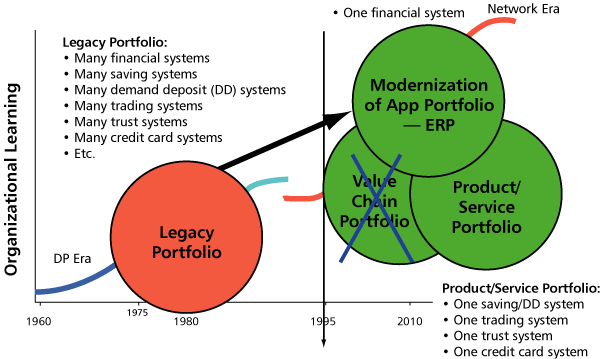
Figure 5 -- Example financial institution legacy applications portfolio migration.
Overcoming Management Difficulties Through an IT-Savvy CEO
Against the background of dramatic changes in the financial services industry came IT-savvy Jamie Dimon who would lead the transformation of a regional bank conglomerate, one that had grown through aggressive acquisitions, into a "still standing," well-integrated, and smoothly functioning financial institution powerhouse. The result: JP Morgan Chase. Dimon's leadership approach, especially in his understanding of the strategic value of IT, contributed greatly to the success of the transformation.
Here's the story. Dimon inherited a heterogeneous set of financial services companies that had been cobbled together over several years. Individual companies had continued to maintain their own identities as well as their own IT systems for servicing customers. Efforts to integrate the systems within these large, heterogeneous companies led to an explosion in the cost structure and simultaneous declines in customer service levels. The situation -- at what was then known as "Bank One," -- was dire.
Chosen by the board of directors to turn around the company, Bank One hired Dimon in the spring of 2000. Bank One had experienced a sharp decline in revenues and suffered the residual effects of its megamerger with First Chicago NBD. Not only did the two firms need to rationalize their respective systems, but each firm also had, individually, multiple systems from years of M&As.
Next, JPMorgan Chase merged with Bank One in 2004, adding to the heterogeneous mix. Dimon became the COO of the new combined company and, in 2006, succeeded William Harrison Jr. as CEO. While COO, and then later as CEO, Dimon set about rationalizing the organization and reducing the number of computer banking systems from hundreds into a single unified system.
Dimon pursued two main areas of IT potential: a single banking IT system and a single management reporting IT system.
1. Single Banking IT System
A single banking IT system within all divisions of the company would allow cross-selling, streamlined training, reduced maintenance costs, increased transparency, and the change to a "customer as asset" model. However, Bank One had seven deposit networks, 11 loan systems, three teller platforms, and five wire-transfer arrangements. A complex network of outsourcers maintained the multiple IT systems at Bank One, with jurisdiction over each system handled by the relevant banking division.
First, consider the management challenges. The employees, managers, and directors had aligned themselves into factions along the lines of the legacy banks that comprised Bank One: Banc One Corporation and First Chicago NBD Corporation. Banc One was a more aggressive entrepreneurial culture, while First Chicago NBD had a very conservative culture. The legacy of regional banking also led to a culture of customer ownership, where managers acted as gatekeepers to access important customers. In addition, the series of mergers had created a ballooning number of middle managers who protected their most beneficial compensation plans. The unwillingness of managers to rock the boat and to force costly changes on the firm after several expensive mergers resulted in stagnation.
In comes Dimon's leadership. Dimon used his first 100 days to learn about the IT systems in place at Bank One, spending a quarter of his time on IT -- probably a new record for a banking CEO. He also brought in key personnel who had worked with him in the past. Bringing in a team that worked with the CEO in the past is an important point. IT plays a pivotal role in the business transformation required to realizing potential 21st-century IT value. Further, this is not an individual sport, so to speak; business transformation is a team effort, requiring a team that shares the vision and jointly possesses the required capabilities.
Another important point is dealing with blockage. Here, Dimon removed key blocking managers. These actions provide the basis for a major observation: a key to success in using IT to create new capabilities and business value was in Dimon's attention to the composition of his leadership team, especially team members' attitudes toward transition.
With the right leadership team in place, Dimon created the wherewithal to achieve major cost savings through consolidation, rearranging outsourcing contracts, and eliminating needless duplication. Through his leadership team, which shared his vision for the transformation, he accomplished a change in company culture to a view of "the customer as a shared asset" rather than an owned relationship by a particular business unit or manager. Considering the customer as a corporate asset broke down the gatekeeping of clients by business units, and eventually led to greater cross-selling of services across business units. This leads us to another important observation: Dimon's selected leadership team accomplished culture change important to the realization of IT value. Choosing the right leadership provides an instrument for changing the culture in ways that lead to value realization.
2. Single Management Reporting IT System
Dimon implemented a single management reporting system in all business units to increase individual accountability, improve information at the corporate level, and align the focus of the managers with their specific group-level goals. This action countered a pervasive lack of accountability within banking management. In some cases, managers approved their own actions and expenditures without constraint (e.g., time and expense reporting). Further, there were no effective reporting structures in place to give headquarters information about the riskiness of the assets in the bank portfolio; thus, poor communication between divisions and other "fiefdoms" made management reporting futile. Each legacy division rallied behind its systems of compensation and reporting. The single management reporting system helped conquer all these management challenges.
So how did Dimon's leadership address these problems? He devoted a great deal of personal time to the design of a new executive management report (EMR) IT system. The EMR adopted philosophies Dimon espoused: "If you can track it, do track it" and "One company, one consistent set of numbers." The goal of the EMR system was to give managers a better sense of their true costs and profit margins.
The system itself was adaptable to each manager to provide information that mattered to a particular line of business (e.g., sales, customer attrition, purchase credit, customer service, audits, or interest rate exposure). Once the system was operational, Dimon met with individual managers to provide a hands-on demonstration of the system, including instructions on how he wanted it used. The EMR required each division and manager to submit information directly to Dimon. This accountability system played a critical role in helping JPMorgan Chase avoid some risk management problems.
Coupled with a more effective risk management system, an additional factor contributed to JPMorgan Chase, avoiding the serious problems encountered by other financial services firms that became visible during the financial crisis. Dimon personally drove the value of "do the right thing" deep into the JPMorgan Chase management culture. Dealing in high-risk, mortgage-backed securities -- at the current levels of that time -- just did not seem to be "doing the right thing" by Dimon and his management team.
Summary and Findings
The following are three key findings about potential IT benefits and their capture from the JP Morgan Chase case:
- IT plus digitization enables efficient global vertical integration as well as efficient virtual global integration. The JPMorgan Chase case demonstrates that IT plus digitization can enable a continuum of efficient global structures. On one end of the continuum is the traditional vertical integration typical of the 20th century whereby a company owns the business units that create and distribute all aspects of a product or service, as in the case of JP Morgan Chase. On the other end of the continuum, the same level of integration can be accomplished, not by ownership, but by virtual integration of strategic partners, as in the case of the Boeing 787 project.
- Industry expertise matters for effective IT leadership and associated organizational restructuring necessary for capturing potential strategic IT value. Dimon spent his whole career in the financial services industry with hands-on savvy use of IT. This deep knowledge enabled him to lead by example rather than only by speech and written directions and memos. Further, Dimon was able to access a former team that he had built to tackle the difficult challenges of business transformation of a conglomerate of 20th-century financial companies into a vertically integrated 21st-century financial services company.
- Imbalance between IT and people is an ever-present threat to the viability of companies and even industries. The early visions of the Internet appropriately viewed the role of IT as a symbiotic relationship with human judgment. IT was not just "automation" of what a person does, but rather augmentation of human judgment and other capabilities. The JPMorgan Chase case, considered against the backdrop of the world financial services crisis, alerts us to the possibility of avoiding this man-machine imbalance. Dimon saw the imbalance in respect to effective risk management in the industry. As the industry evolved from local banking -- a local banker assessing risk by personal interviews and local knowledge -- to a point at which scoring software abstractly assessed risk and packaged banking into mortgage-backed securities that were traded in the global exchange market, accountability for the risk in decisions went missing, and human judgment was left out of the decision processes. This proved, for many firms, though not for JPMorgan Chase, catastrophic. Yet, the conditions for catastrophe had existed at Bank One and JPMorgan prior to Dimon's arrival. Loan officers were not directly accountable for the information they put in the loan processing system and were paid based on the number of loans they closed. Dimon ended that pattern, saving the company substantial difficulties.
Further, the JPMorgan Chase case illustrates another important aspect of the senior management team: the tacit aspect of human leadership. The principle of "do the right thing" assumes, after the fact, that not all management behavior can be legislated with precise definition. "Doing the right thing" can be known by humans, but not fully defined in abstract language.
Key Comparisons with Boeing and JPMorgan Chase
As we close this portion of our two-part Executive Report series, the most striking difference that emerges in comparing Boeing with JPMorgan Chase has to do with how the two companies differed in retaining key integration skills during the execution of an IT-based transformation. Both faced formidable systems integration tasks, but JPMorgan Chase's Dimon succeeded in rising above the cultural clashes that dogged Boeing even at the highest levels of that company. The key action taken by Dimon appears to have been his aggressive moves to (1) install a senior team composed of trusted allies hired into the company and (2) remove blocking executives. With this tactic, JPMorgan Chase achieved much more success in retaining key integration talent than Boeing. These complementary skills -- mainly adaptability and integration skills present in the most experienced and talented employees -- appear to be key to creating new capabilities and realizing value from IT.
Stay tuned for Part II, where we'll explore the case studies of "Delta XYZ," crowdsourcing, and Ascent Media. We will also reveal our set of 12 overall findings that constitute the bulk of our results.
ENDNOTES
1 Bush, Vannevar. "As We May Think." Atlantic Magazine, July 1945.
2 Licklider, J.C.R., and Robert W. Taylor. "The Computer as a Communication Device." Science and Technology, September 1968.
3 Carr, Nicholas. "IT Doesn't Matter." Harvard Business Review, 1 May 2003.
4 "Boeing 787 Makes Maiden Flight." ReutersVideo, 15 December 2009 (www.youtube.com/watch?v=Fucq5BoEfEI).
5 Nolan, R.L. "Information Technology Management Since 1960." In A Nation Transformed by Information: How Information Has Shaped the United States from Colonial Times to the Present, edited by A. Chandler and J. Cortada. Oxford University Press, 2000.
6 Greve, Henrich. "Boeing 787 Dreamliner: Success Through a New Manager?" INSEAD, 8 March 2012 (http://blog.insead.edu/2012/03/boeing-787-dreamliner-success-through-a-new-manager).


